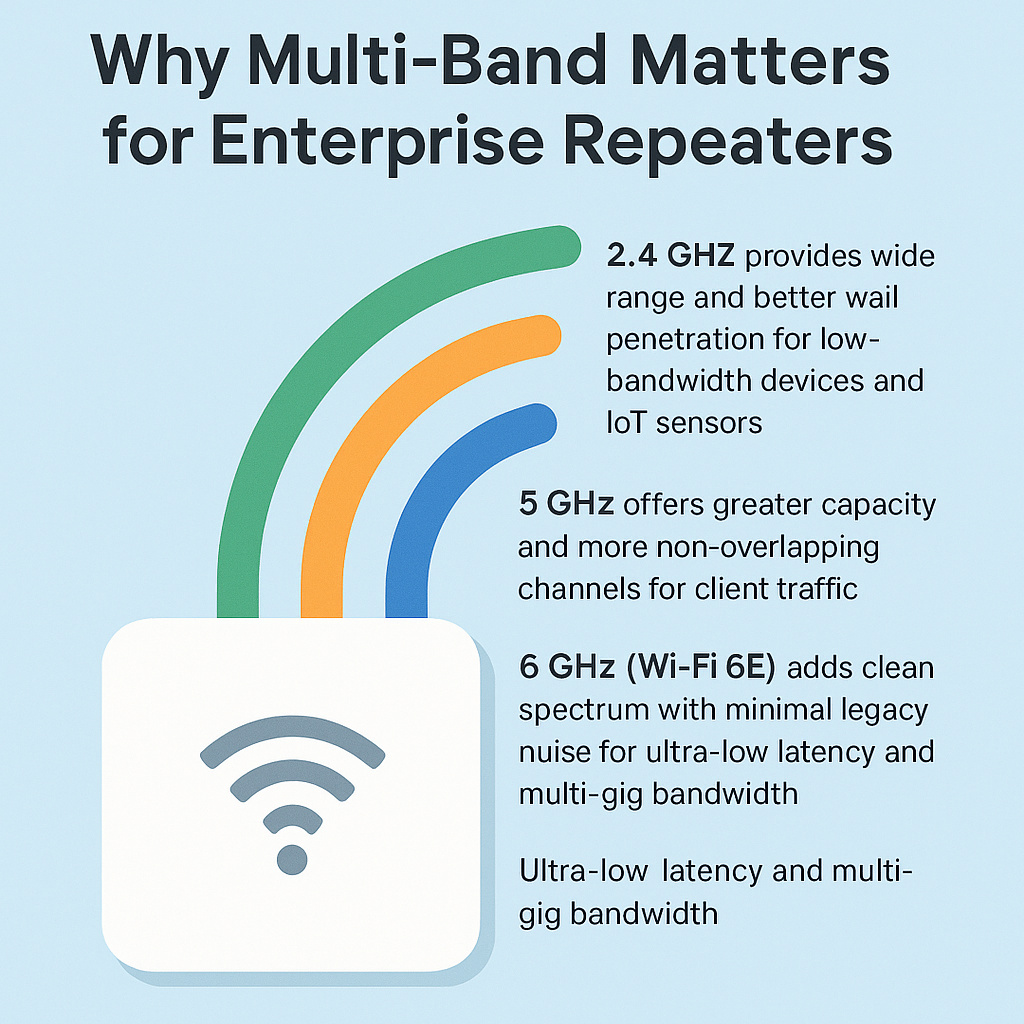Wireless coverage isn’t just about covering every corner of a building anymore. For modern businesses, consistent throughput, low latency, and predictable device density are equally important. Multi-band wireless access—with repeaters and nodes operating in the 2.4 GHz, 5 GHz, and increasingly popular 6 GHz bands—turns simple coverage extension into a performance-enhancing tool. Toda’s multi-band Wi-Fi repeaters are designed to deliver reliable performance in offices, factories, campuses, and outdoor locations.
Why Multi-Band is Important for Enterprise Repeaters
2.4 GHz offers longer range and better wall penetration for low-bandwidth devices and IoT sensors.
5 GHz provides greater capacity and more non-overlapping channels for client traffic.
6 GHz (Wi-Fi 6E) adds clean spectrum and minimizes traditional noise, enabling ultra-low latency and multi-gigabit bandwidth.
When a repeater can operate on multiple bands simultaneously, it can balance client access, dedicate one band to backhaul, and avoid the severe throughput penalties that plague single-radio extenders.
The core multi-band functionality that distinguishes Toda repeaters
1.Tri-band architecture with dedicated backhaul
A dedicated backhaul radio (typically a second 5 GHz or 6 GHz radio) prevents client traffic from sharing the same air time as the uplink, maintaining throughput and reducing latency.
2.Native Wi-Fi 6 / 6E support
Support for OFDMA, MU-MIMO, and wider channels enables greater efficiency under load and high concurrency in dense device environments.
3.Band steering and intelligent load balancing
The repeater automatically steers capable devices to 5 GHz or 6 GHz and distributes clients among nodes to avoid saturation.
4.Dynamic channel selection and DFS compliance
Automatic channel switching and DFS support enable the repeater to operate in the cleanest spectrum while complying with regulatory requirements.
5.Centralized Policy and RF Coordination
Toda’s management platform synchronizes channel, power, and band policies between APs and repeaters so that multi-band structures can operate as a single optimized system.
How to realize commercial value of multi-band repeaters
Maintain throughput: Dedicated backhaul avoids the 50% throughput loss common with single-radio repeaters.
Improved roaming and user experience: Devices can switch more smoothly when neighboring nodes have non-conflicting band plans.
Supports a diverse mix of devices: IoT sensors, handheld scanners, VoIP phones, and laptops can all choose the frequency band that best suits their needs.
Future-proof network: Wi-Fi 6E-enabled repeaters prepare campuses for next-generation applications such as AR training, high-resolution video analytics, and multi-gigabit cloud services.
Deployment patterns and best practices
1.Start with a site survey and heatmap: identify dead zones, interference sources, and client density peaks.
2.Use tri-band repeaters where client density or throughput is important: Dedicate one radio to backhaul.
3.Prefer wired uplinks where feasible: Multi-Gigabit Ethernet or SFP links completely eliminate concerns about wireless backhaul.
4.Adjust transmit power and overlap: Ensure good roaming behavior without excessive co-channel interference.
5.Enables band steering and airtime fairness: Prioritizes latency-sensitive traffic and prevents legacy devices from monopolizing airtime.
6.Place 6 GHz in high-value, low-interference areas: Laboratories, control rooms, or dedicated production areas benefit most from pristine spectrum.
Typical enterprise use cases
Warehouse and logistics: 2.4 GHz for rugged scanners, 5 GHz for handheld terminals, and 6 GHz for backhaul for real-time inventory analysis.
Manufacturing floor: Mission-critical control telemetry on 6 GHz or dedicated backhaul, and mobile operator equipment on 5 GHz.
Campuses and outdoor plazas: Outdoor repeaters use multi-band radios to separate guest access and employee/IoT traffic while maintaining performance.
Temporary venues and events: Zero-touch tri-band repeaters provide fast, reliable access for guests and staff without the need for new wiring.
Shopping List – What Businesses Should Ask For
Tri-band hardware with configurable dedicated backhaul radio.
Native Wi-Fi 6/6E support with cross-band parity capabilities (OFDMA, MU-MIMO, air time fairness).
Multi-Gigabit Ethernet or SFP uplink options and PoE/PoE++ support.
Centrally manage with band strategies, automated channel planning, and analytics.
Regulatory compliance in target markets (DFS treatment, regional power restrictions).
If necessary, ruggedized SKUs are available for outdoor or industrial deployments.
Security and operational controls
Maintain VLAN and SSID segmentation across bands so that guest, IoT, and corporate traffic do not inadvertently mix.
Enforce WPA3-Enterprise with 802.1X for device authentication on all bands.
Protect configuration and telemetry using secure management channels and role-based access.
Monitor airtime, retransmissions, and noise floor on each band to quickly detect and mitigate interference.
Measuring Success – Key KPIs to Track
Total throughput per coverage area (before/after repeater deployment).
Average client PHY rate and air time utilization per band.
Roaming switching time and session continuity for voice or video.
The number of repeaters required to meet the SLA in each area (the fewer the better when using multi-band repeaters).
Reduce help desk tickets related to dead zones and wireless performance.
Why global B2B customers choose Toda
Toda combines multi-band repeater hardware with engineering services, RF planning, and lifecycle support. Our solutions are designed to integrate with Toda access points, switches, and controllers, helping enterprises achieve a scalable, end-to-end wireless architecture. Customers benefit from predictable deployment, clear procurement documentation, and a global support model purpose-built for multi-site deployments.
Call to Action
If your organization is planning to expand coverage or prepare to deploy Wi-Fi 6/6E, Toda can provide customized assessments, SKU recommendations, and pilot programs. Contact Toda’s enterprise team to schedule a site survey and learn how multi-band repeaters can transform shadowed areas into high-performance coverage.
Keywords (for SEO): multi-band Wi-Fi repeater, tri-band repeater, Wi-Fi 6E repeater, enterprise wireless extension, dedicated backhaul repeater, Toda Network Solutions.
Post time: Oct-27-2025




